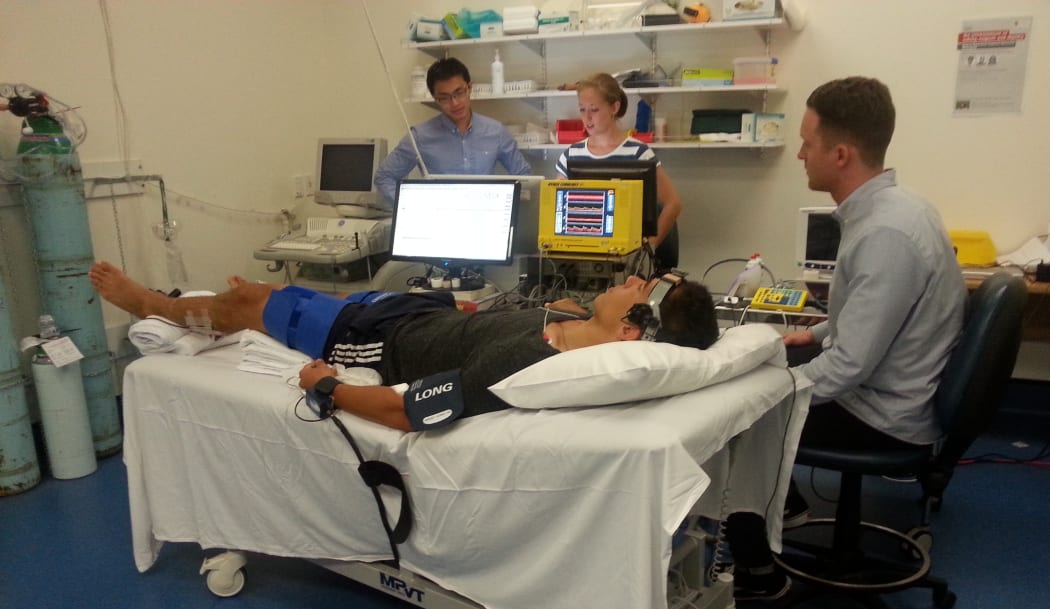by Ruth Beran
Personalised medicine – or tailoring treatment to the individual patient - is a buzzword in healthcare these days and it’s something that the medical profession is aiming towards.
“To [individualise medicine] you need to understand, at a very fundamental level, why it is that we are different, and how we’re different. And what systems and mechanisms are involved,” says physiologist Dr Shieak Tzeng.
To better understand how people differ, Shieak and his team are running tests at the University of Otago Wellington School of Medicine on healthy people to determine how blood flow to the brain is regulated. What they’re finding is surprising: individuals regulate blood flow very differently.

From left to right: researchers Shieak Tzeng, Chloe Taylor, Trevor Witter and healthy volunteer AJ on the bed in the clinic Photo: RNZ / Ruth Beran
In particular, they’re looking at two mechanisms that regulate blood flow: the baroreflex and autoregulation.
The baroreflex is a pressure sensing reflex which sends out a signal when it detects a change in blood pressure. Every time blood pressure drops, it results in an increase in heart rate. The baroreflex is also driven by nerve activity.
Autoregulation is another key player in the regulation of blood flow and the system operates by changing the diameter of blood vessels in the brain in response to changes in blood pressure.
These two systems overlap in function and purpose, and Shieak Tzeng and his team are trying to get a more accurate picture of how these two systems combine to achieve integrated brain blood flow regulation in the body.
“Essentially it’s trying to understand what normal actually is,” says Shieak. “That may allow us to come up with more targeted treatment strategies or monitoring strategies because evidently not everyone is the same, so we’re trying to understand why there are these differences between individuals.”
In the past, it has been assumed that if a person has poor baroreflex function then they are at higher risk of strokes, blood pressure disease, high blood pressure, and are more likely to have poor outcomes following a heart attack. However it’s been found that people with poor baroreflex function are still able to function normally with apparently no problems. “What we’ve come to realise is that…it’s not that they can’t regulate blood flow because they have a poor baroreflex, it’s that they rely on other organ systems,” says Shieak.
So autoregulation and the baroreflex counterbalance each other. “In a population of individuals you’ll find people that…are baroreflex reliant, [who] rely on the heart and blood vessels to maintain brain perfusion, and then there is a group of people who…primarily rely on autoregulation.”
What Shieak and his team want to do is work out a way to predict which mechanism a person relies on.
“We’re looking at what drives the changes in blood pressure and those inter-individual differences. What cause some people to respond more than others,” says Chloe Taylor, a lecturer at the University of Western Sydney.
To do that, healthy participants are put through a gruelling set of tests which include injection with intravenous drugs which manipulate heart pressure (sodium nitroprusside and phenylephrine), a cold presser challenge which involves plunging the participant’s hand in icy water for two minutes, a hand grip test, a colour word test, and a mental arithmetic test. According to University of Otago Masters student Trevor Witter, the last is a “crowd favourite, I get a little stressed out just thinking about it, so it’s a pretty good test.”
While all of these tests are going on, the participants are being monitored for blood pressure, heart rate, nerve activity, ultrasound is used to image blood vessels, and transcranial Doppler probes are measuring vascular responses in the brain vessels.
When Our Changing World met the team, 37 participants had been tested, and the next step will be to analyse the data to try and tease out the components. This is a complex process that will use statistical techniques borrowed from economics to look at the signals in more detail.
And over the next couple of years, Shieak will be trying to answer questions like: Is blood flow driving blood pressure or is the blood pressure driving the flow? Is it the brain that’s important or is blood flow to the arm, to the heart, to the kidneys the important factor?
Ultimately though, it’s about trying to individualise medicine.
Listen to another experiment conducted by Shieak testing the impacts of binge drinking on cardiovascular function here.

